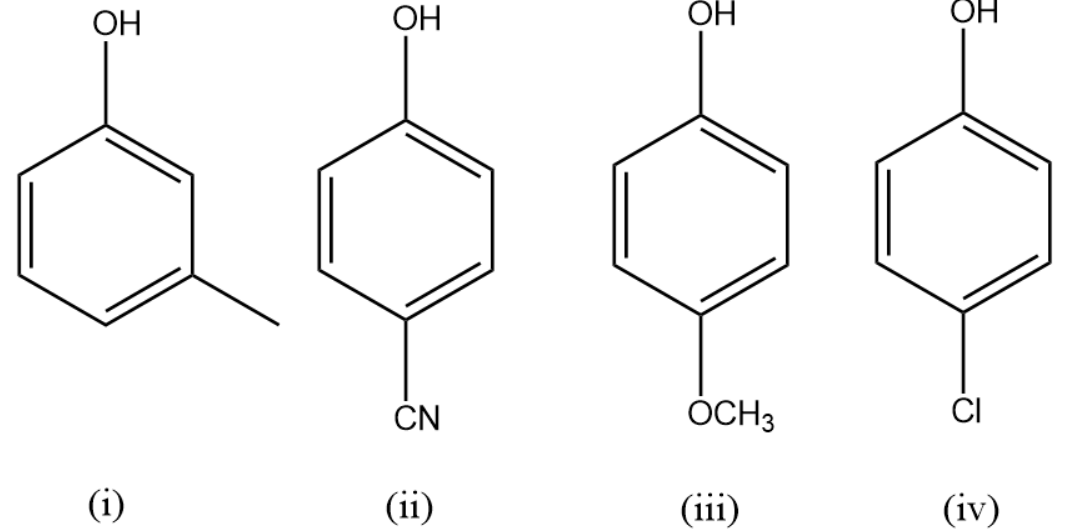
Increase order of acidic strength of given compounds is :

(A) (ii) < (i) < (iv) < (iii)
(B) (i) < (iii) < (iv) < (ii)
(C) (i) < (iii) < (ii) < (iv)
(D) (iii) < (i) < (iv) < (ii)
Answer
118.5k+ views
Hint: The four organic compounds have the hydroxyl group in common. The acidic strength of the compounds can be determined by the stability of the conjugate base formed. Only when the conjugate base formed is stable, the hydrogen ion will be released easily. The groups attached will contribute to either stabilizing or destabilizing the negative charge after deprotonation.
Complete step by step solution:
Electronic factors are the factor that influences carious organic reactions and rearrangements. Electronic effects are significantly observed in organic aromatic compounds.
Electronic factors are:
- Inductive effect
- Resonance
- Mesomeric effect
- Electromeric effect
- Hyperconjugation.
We will now identify at which position of the aromatic ring, the following effect is observed.

In the above compound,
- o stands for ortho-position
- m stands for meta-position
- p stands for para-position
In compound (i) the anion of the compound or the conjugate base is destabilised only by inductive effect as the methyl group is attached at the meta position.
In compound (ii) the conjugate base is stabilised by the cyanide or nitrile group attached at the para position as it withdraws electrons from the benzene ring
In compound (iii) the conjugate base is destabilised by the ether group attached at para-position as the oxygen atom increases electron density in the ring making it unstable.
In compound (iv) the conjugate base is mildly stabilised by the halogen atom attached at the para position.
Therefore, the increasing order of acidic strength of the given compounds is (iii) < (i) < (iv) < (ii).
The correct answer is option (D).
Note: Resonance effect is mainly observed in the ortho and para position of the aromatic ring and the only significant electronic effect observed at meta position is the inductive effect. Resonance has much more priority than inductive effect while determining the acidic strength of phenols or carboxylic acids.
Complete step by step solution:
Electronic factors are the factor that influences carious organic reactions and rearrangements. Electronic effects are significantly observed in organic aromatic compounds.
Electronic factors are:
- Inductive effect
- Resonance
- Mesomeric effect
- Electromeric effect
- Hyperconjugation.
We will now identify at which position of the aromatic ring, the following effect is observed.

In the above compound,
- o stands for ortho-position
- m stands for meta-position
- p stands for para-position
In compound (i) the anion of the compound or the conjugate base is destabilised only by inductive effect as the methyl group is attached at the meta position.
In compound (ii) the conjugate base is stabilised by the cyanide or nitrile group attached at the para position as it withdraws electrons from the benzene ring
In compound (iii) the conjugate base is destabilised by the ether group attached at para-position as the oxygen atom increases electron density in the ring making it unstable.
In compound (iv) the conjugate base is mildly stabilised by the halogen atom attached at the para position.
Therefore, the increasing order of acidic strength of the given compounds is (iii) < (i) < (iv) < (ii).
The correct answer is option (D).
Note: Resonance effect is mainly observed in the ortho and para position of the aromatic ring and the only significant electronic effect observed at meta position is the inductive effect. Resonance has much more priority than inductive effect while determining the acidic strength of phenols or carboxylic acids.
Recently Updated Pages
Difference Between Crystalline and Amorphous Solid

JEE Main Maths Paper Pattern 2025 – Marking, Sections & Tips

Common Ion Effect Important Concepts and Tips for JEE

Colour of Ions and Precipitates Important For JEE

COM of Semicircular Ring Important Concepts and Tips for JEE

JEE Amino Acids and Peptides Important Concepts and Tips for Exam Preparation

Trending doubts
Free Radical Substitution Mechanism of Alkanes for JEE Main 2025

Electron Gain Enthalpy and Electron Affinity for JEE

Collision - Important Concepts and Tips for JEE

JEE Main Chemistry Exam Pattern 2025

JEE Main 2023 January 25 Shift 1 Question Paper with Answer Keys & Solutions

Aqueous solution of HNO3 KOH CH3COOH CH3COONa of identical class 11 chemistry JEE_Main

Other Pages
NCERT Solutions for Class 11 Chemistry In Hindi Chapter 7 Equilibrium

Inductive Effect and Acidic Strength - Types, Relation and Applications for JEE

The number of d p bonds present respectively in SO2 class 11 chemistry JEE_Main

JEE Main 2025: Application Form, Exam Dates, Eligibility, and More

Christmas Day History - Celebrate with Love and Joy

Essay on Christmas: Celebrating the Spirit of the Season




